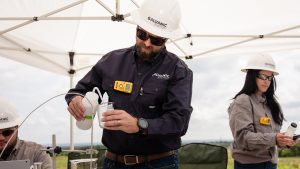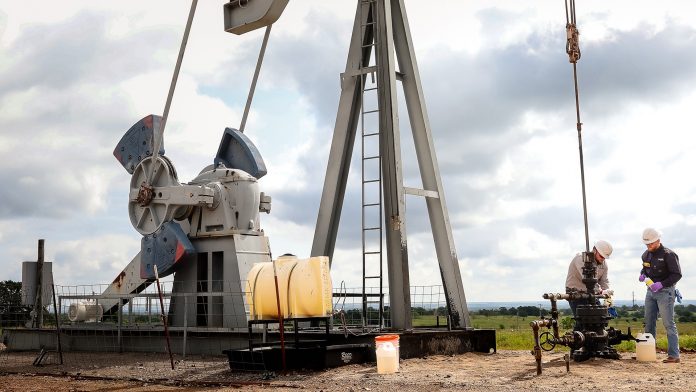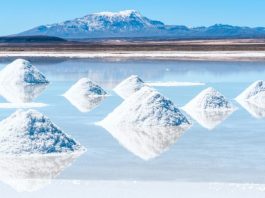Brent Wilson, founder and CEO of Galvanic Energy, discusses how his company is helping boost US lithium resources by discovering new prospects that can be developed and produced more quickly than conventional mining projects.
Galvanic energy is back on the hunt for new lithium resources after amassing and selling a 120,000-acre, four-million-tonne LCE prospect in the Smackover Formation in southern Arkansas. The company aims to unlock the potential of additional deep US reservoirs.
Founded in 2018, Galvanic Energy, an exploration and development company based in Oklahoma City, Oklahoma, is cut from a different cloth than other companies in the lithium space.
With expertise in both the environmental and petroleum industries, the Galvanic team brings a strong mix of skill sets to the table, leading to new discoveries of ‘white gold’, a key ingredient in electric vehicle (EV) batteries.
To learn more about this innovative lithium explorer and its future plans, The Innovation Platform interviewed Galvanic Energy founder and CEO, Brent Wilson.
What motivated you to start a lithium exploration company?
When Tesla transformed EVs from funny-looking aero compacts to supercool sports cars to practical, highly desired sedans and SUVs, it quickly became apparent that EVs had the potential to establish a new niche in the automobile industry.
That was the lightbulb moment. The US was going to need more raw materials to produce them. Lithium is the common element of batteries used in EVs, but the US only produces 1-2% of the world’s lithium. Therefore, it was a safe bet that the lithium market was about to take off.

After more than a decade of working in the oil and gas industry, I approached a couple of former colleagues about joining me in a lithium exploration start-up venture.
Having had previous conversations about our shared interest in the lithium space, this new opportunity was an easy sell. Given our experience in exploration, reservoir modelling, and geochemistry, we believed we could discover new, untapped lithium resources in deep basin reservoirs.
Why is Galvanic focused on deep basin reservoirs?
Lithium is typically produced from open-pit mines and evaporation ponds. Some are enormous in scale and can create undesired impacts, which no one wants to see, hear or encounter, especially in pristine or populated areas. As such, many in our society have developed a NIMBY (not in my backyard) mentality.
When it comes to electrification, there is a lot of interest in EVs, but not at the expense of trading one environmental problem for another. While EVs offer hope for countering climate change, mining raw materials has raised environmental and human health concerns.
This is where we add value and opportunity. Because of our familiarity with the oil and gas industry, we understand both the challenges and benefits the industry has created.
One of the positives is the much smaller and less invasive approach to drilling and producing deep reservoirs versus conventional lithium mining.
Producing and reinjecting brine through well bores is much less invasive and requires little surface space. As a founding associate member of ILiA (International Lithium Association), we are committed to promoting the responsible development and production of lithium.
Additionally, conventional mining of lithium resources is limited to only a few geographic locations within the US, mainly in Nevada, and can only be accessed along or near the surface. However, deeper reservoirs are more prolific across the US. They contain enormous volumes of brine, which can contain economically viable lithium concentrations.
Has Galvanic found other lithium resources besides the Smackover in southern Arkansas?
Most definitely. The Smackover Formation was a great start, but that’s what it was – a start.
We have long known lithium is present in other formations and reservoirs across the US and worldwide. However, for strategic purposes, our primary focus is on the US.
How does Galvanic identify new lithium resources?
There is no single magical thing that drives our exploration approach. We incorporate a long list of criteria. However, it starts with exploration, using a combination of proprietary techniques.
The concentration of lithium in the brine is important and may be the primary driver. However, other critical parameters include brine chemistry, geologic and reservoir data, temperature, and depth.
Other considerations for lithium resources include geographic location, distance to resources, the area’s population, workforce access, and means of transportation.
Why should Americans care about where their lithium comes from?
There are several reasons to care about where our lithium is sourced.
First, it’s a security issue. As America learned from the energy crisis in the 1970s to the more recent impact of COVID-19, dependency on foreign suppliers can become problematic when geopolitical or supply chain bottlenecks arise.
Today, the US produces less than 2% of the world’s lithium, leaving us vulnerable, especially with China, which dominates the world supply chain.
Additionally, by sourcing lithium resources in the US, we dramatically shorten the supply chain, which has major benefits as it relates to decreasing the transportation distances of materials. Firstly, it has the potential to save consumers money by lowering the cost of EV batteries, a significant portion of the EV cost. Secondly, it helps reduce carbon emissions by eliminating the need for global shipping.
American lithium production also supports American workers and businesses. As our prospects reach production, they will create new jobs and stimulate the economy of surrounding communities.
What does the future look like for American lithium exploration?
Given the limited production and capacity currently in the US, I believe in an all-of-the-above approach to lithium sourcing. Already, 2030 lithium demand exceeds the capacity of current and proposed projects, so more will be needed.
While there are numerous lithium mining projects in the western US, there are very few prospects in the middle and eastern sections of the country. We focus on exploring intercontinental deep reservoirs and basins in these areas to help bridge the gap.

What does the future look like for Galvanic Energy?
It’s exciting! We aim to become a leading exploration company for lithium resources and other critical elements essential for an affordable and sustainable energy future.
Our Smackover prospect is proof of concept, and we are searching to discover additional prospects. Even though the Smackover has the potential to produce enough lithium to power 50 million EVs, more will be needed to meet the rapidly growing market demand.
We will also continue to evaluate the effectiveness of new technologies that are being developed to extract lithium from brine resources. It is also important to us that our prospects be produced in a way that protects the environment and benefits the communities in which we work.
The future is bright for Galvanic Energy because the future is bright for American lithium resources.









